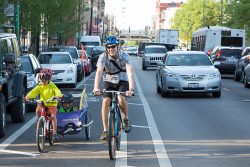 The birds are singing, the flowers are blooming, and if you listen close enough you just might be able to hear the chirping of a frog coming from a nearby stream. Spring is just around the corner and that means hundreds of cyclists will be taking to the road as they wake from their winter slumber.
The birds are singing, the flowers are blooming, and if you listen close enough you just might be able to hear the chirping of a frog coming from a nearby stream. Spring is just around the corner and that means hundreds of cyclists will be taking to the road as they wake from their winter slumber.
With that in mind, we’ve put together a list of tips to help drivers and cyclists share the road so they can avoid a potentially fatal accident. These tips recognize the fact both motor vehicles and bicycles have a right to be on the road and must follow a series of rules and regulations as part of this responsibility.
Drivers:
- Give three feet of space: State law requires drivers to make sure there is at least three feet of space between their vehicle and any cyclist they pass on the road. Drivers who can’t yield this space due to oncoming traffic or road conditions must reduce their speed to one that “is reasonable and prudent” and only pass the cyclist when he or she will not be put in danger¹.
- Keep your eyes open: According to the California Department of Motor Vehicles, drivers should look carefully for cyclists when turning their car or changing lanes, before opening their door when parked on the street, and when entering traffic. Bicycles are very small and can easily be hidden in a vehicle’s blind spot.
Cyclists:
- Stay to the right: State law requires cyclists to ride with the flow of traffic and stay in a designated bike lane or as far to the right as possible if they’re going slower than the other vehicles on the road. The only exceptions to this rule are when a cyclist is passing another cyclist, avoiding a road hazard, making a left turn, or going down a one-way street².
- Stay visible: Much like drivers, cyclists should use turn signals to let vehicles know when they plan on changing lanes or turning at an intersection. They’re also required by state law equip their bicycles with lights and reflectors so they can be seen at night.
Finally, drivers and cyclists should do their best to remain calm and call the police if they do get into a wreck. They should share their contact information and try to get the same from any witnesses who may have seen the crash regardless of who is at fault³.
Sources:

